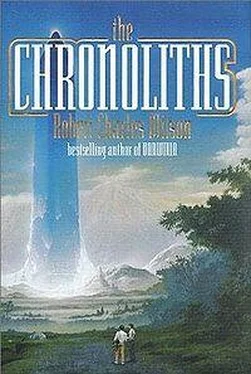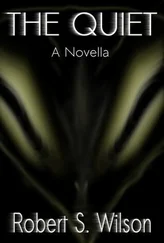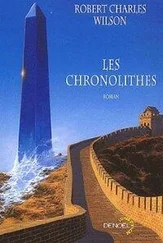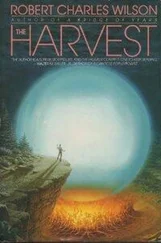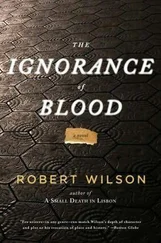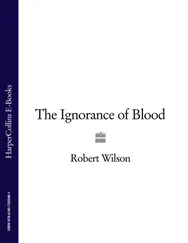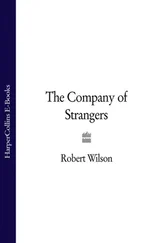We were there, Kait, you and I, I thought.
Ruined Bangkok from the air looked like a misprinted road map. I recognized the Chao Phrya bending through the city, and the devastated Rattanakosin district, the old Royal City, where the Khlong Lawd fed the larger river. A patch of green might have been Lumphini Park. But the gridwork of roads had been reduced to an incomprehensible wasteland of brick and rebar, tin and cardboard and frost-heaved asphalt, all glittering with ice and wound about with fog. The ice had not prevented a number of broken gas mains from catching fire, islands of flame in the glacial wreckage. A great many people had died here, as the commentators took pains to point out. Some of the baggy objects littering the streets were almost certainly human bodies.
The only intact structure closer than the suburbs was at the very center of the disaster: the Chronolith itself.
It was not much like the Chumphon Chronolith. It was taller, grander, more intricately detailed and more finely sculpted. But I immediately recognized the translucent blue surface visible where patches of frost had peeled away, that distinct, indifferent skin.
The monument had “arrived” (explosively) after dark, Bangkok time. These clips were more recent, a few from the chaotic night, most fresh this morning. As time passed, the news networks relayed more aerial video. It was possible to see the new Chronolith in a kind of montage as it shed its cloak of condensed and frozen moisture, changing from what it had seemed to be — a monstrously large, oddly bulky white pillar — into what it really was: the stylized form of a human figure.
It recalled more than anything else the public monuments of Stalinist Russia; the Winged Victory at Leningrad, say. Or maybe the Colossus of Rhodes astride its harbor. Such structures are daunting not only because they are enormous but because they are so coldly stylized. This was not an image but a schematic of a human being, even the face contrived to suggest some generic Eurasian perfection unattainable in the real world. Scabs of ice clung to the domes of the eyes, the crevasses of the nostrils. Beyond its apparent masculinity, the figure might have been anyone. At least, anyone in whom infinite confidence had colluded with absolute power.
Kuin, I supposed. As he would have us see him.
His torso blended into the fundamental columnar structure of the Chronolith. The base of the monument, maybe a quarter mile in diameter, straddled the Chao Phrya, and skins of ice had formed where it met the water. These were breaking up in the sunlight and floating downstream, ice floes in the tropics, bumping the half-sunken hulls of tourist barges.
Janice called at ten, demanding to know what I had done with Kait. I looked at my watch, gritted my teeth and apologized. I explained to Janice how we had spent the day and how I had become distracted by the Bangkok Chronolith.
“ That thing,” she said, as if it were already old news. And maybe for Janice it was: she had already processed the Chronoliths into a generalized symbolic threat, terrifying but distant. She seemed unhappy that I had brought it up.
“I can drive Kaitlin back tonight,” I said, “or keep her until morning if that’s more convenient. She’s asleep on the sofa right now.”
“Get her a pillow and a blanket,” Janice said, as if that thought had not already crossed my mind. “I guess she might as well sleep through.”
I did better than that: I carried Kaitlin to the bed and took the sofa for myself. Sat up nearly until dawn watching TV with the sound turned low. The commentary was inaudible and probably better that way. Only the images remained, growing more complex as news crews pushed deeper into the rubble. By morning Kuin’s vast head was wreathed in cloud, and rain had begun to dampen the burning city.
In the summer of that year (the summer Kaitlin learned to ride the bicycle I bought her for her birthday), a third Chronolith cored the living heart out of Pyongyang, and the Asian Crisis began in earnest.
Time passed.
Should I apologize for these lapses — a year here, a year there? History isn’t linear, after all. It runs in shallows and narrows and bayous and bays. (And treacherous undertows and hidden whirlpools.) And even a memoir is a kind of history.
But I suppose it depends on the audience I’m writing for, and that’s still unclear in my mind. Who am I addressing? My own generation, so many of whom have died or are now dying? Our heirs, who may not have experienced these events but who can at least recite them from schoolbooks? Or some more distant generation of men and women who may have been allowed, God willing and impossible as it seems, to forget a little of what passed in this century?
In other words, how much should I explain, and how thoroughly?
But it’s a moot question.
Really, there are only two of us here.
Me. And you. Whoever you are.
Nearly five years passed between my visit to the mall with Kaitlin and the day Arnie Kunderson called me out of a batch-sort test to his office — which was, perhaps, the next significant turning point in my life, if you believe in linear causality and the civilized deference of the future to the past. But taste those years, first: imagine them, if you don’t remember them.
Five summers — warm ones, when the news (between Kuin events) was dominated by the ongoing depletion of the Oglalla Aquifer. New Mexico and Texas had virtually lost the ability to irrigate their dry lands. The Oglalla Aquifer, a body of underground water as large as Lake Huron and a relic of the last ice age, remained essential to agriculture in Nebraska, parts of Wyoming and Colorado, Kansas and Oklahoma — and it continued to decline, sucked up from increasing depths by ruthlessly efficient centrifugal pumps. The news feeds featured the farm exodus in repetitive, blunt images: families in battered cargo trucks stalled on the interstates, their sullen children with web toys plugging their ears and masking their eyes. Men and women standing on labor lines in Los Angeles or Detroit, the dark underside of our blossoming economy. Because most of us had work, we allowed ourselves the luxury of pity.
Five winters. Our winters were dry and cold, those years. The well-to-do wore thermally adaptive clothes for the first time, which left the tonier shopping districts looking as if they had been invaded by aliens in polyester jogging suits and respirators, while the rest of us beetled down the street in bulging parkas or stuck as close as possible to the skywalks. Domestic robots (self-guided vacuum cleaners, lawnmowers bright enough not to maim local children) became commonplace; the Sony dogwalker was withdrawn from the market after a well-publicized accident involving a malfunctioning streetlight and a brace of Shi Tzus. In those years, even the elderly stopped calling their entertainment panels “TV sets.” Lux Ebone announced her retirement, twice. Cletus King defeated incumbent Marylin Leahy, giving the White House to the Federal Party, though Democrats continued to control Congress.
Catchphrases of the day, now all but forgotten: “Now give me mine .” “Brutal but nice!” “Like daylight in a drawer.”
Names and places we imagined were important: Doctor Dan Lesser, the Wheeling Courthouse, Beckett and Goldstein, Kwame Finto.
Events: the second wave of lunar landings; the Zairian pandemic; the European currency crisis; and the storming of the Hague.
And Kuin, of course, like a swelling drumbeat.
Pyongyang, then Ho Chi Minh City; eventually Macao, Sapporo, the Kanto Plain, Yichang…
And all the early Kuin mania and fascination, the ten thousand websources with their peculiar and contradictory theories, the endless simmering of the crackpot press, the symposia and the committee reports, the think tanks and the congressional inquiries. The young man in Los Angeles who had his name legally changed to “Kuin,” and all his subsequent imitators.
Читать дальше
